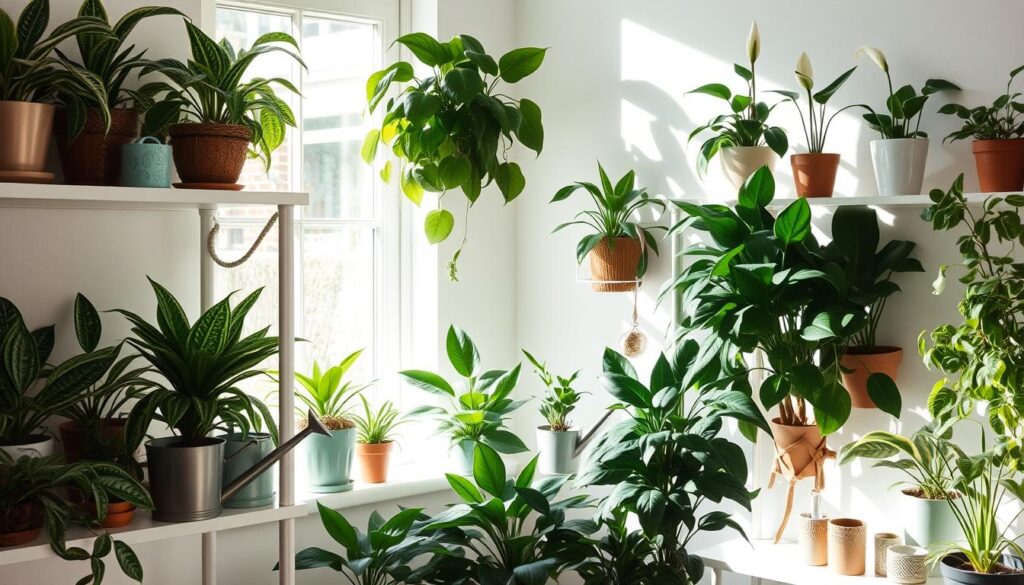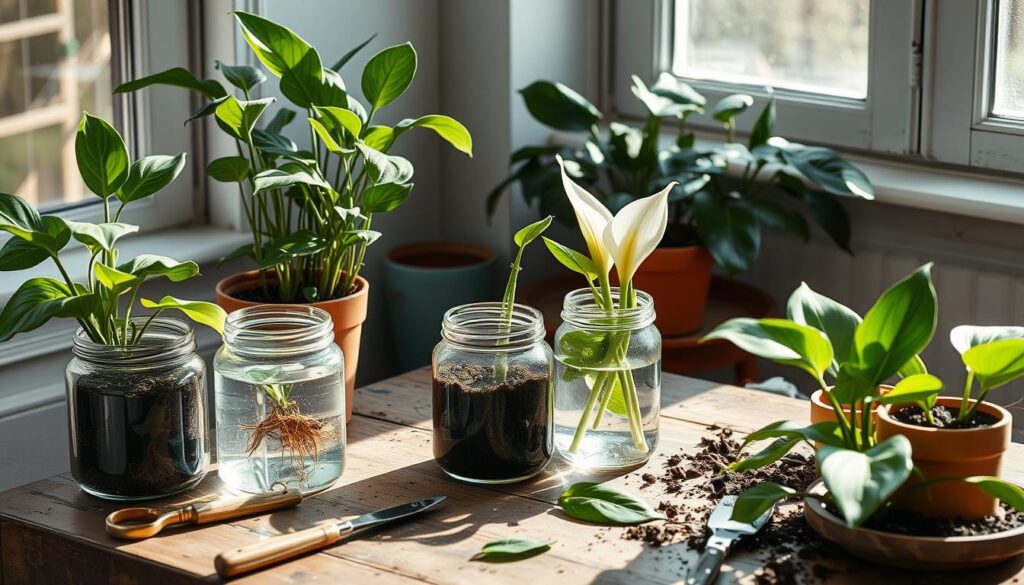Did you know that about 30% of American homes have low light? This makes it hard for regular houseplants to grow well. But, there’s a growing interest in indoor gardening for those looking for plants that do well in low light.
Choosing the right plants can turn dark spots in your home into green, lively areas. These plants don’t just survive; they really thrive. They add beauty and fresh air to places where sunlight is scarce.
In this article, we’ll look at great indoor plants for low light. We’ll also share tips on how to care for and decorate them. This will help you create your own indoor paradise.
Key Takeaways
- Low light conditions are common in many homes, affecting plant growth.
- Understanding which plants thrive in minimal light is essential for successful indoor gardening.
- Indoor plants for low light conditions can significantly enhance your home’s atmosphere.
- These plants offer various benefits, including air purification and stress reduction.
- Caring for low light indoor plants requires specific knowledge regarding watering and fertilizing.
Understanding Low Light Conditions
When we talk about indoor gardening, knowing about low light is key. Low light means areas that get less than 4 hours of direct sun a day. This includes spots that mostly use artificial light, making it important to pick the right plants. Even in these conditions, some plants can add color and life to your home.
What Constitutes Low Light?
Low light spots can’t usually support most houseplants. The amount of natural light in these areas is crucial. Rooms with north-facing windows or shaded spots get much less light. This makes it hard for plants that need more light to thrive. Knowing this helps us find the best plants for dark rooms.
Ideal Placement for Low Light Plants
To help low light plants grow well, where you place them matters a lot. Here are some good spots:
- Corners of rooms that get filtered light
- Northern-facing windows with soft light
- Areas near light fixtures that give off gentle light
Putting your plants in the right spot can help them do better in low light. Picking plants that are good for low light will help them survive and grow.
Benefits of Choosing Low Light Indoor Plants
Adding low light tolerant plants to your home has many benefits. They make your space look better and improve your health. These plants are not just for looks; they also help make your home a healthier place.
Air Purification Qualities
Some low light plants are great at cleaning the air. They remove harmful pollutants from your home. For instance, the Peace Lily and Snake Plant are known for their air-cleaning abilities.
Stress Reduction and Aesthetics
Having plants indoors can make you feel better and look better. Studies show that plants can lower stress and boost your mood. They create a peaceful atmosphere, perfect for unwinding after a busy day.
| Plant | Air Purification Ability | Ideal Light Conditions |
|---|---|---|
| Peace Lily | Removes formaldehyde, benzene | Low to medium light |
| Snake Plant | Filters toxins at night | Indirect light preferred |
| ZZ Plant | Great for overall air quality | Low light conditions |
| Pothos | Absorbs carbon monoxide | Low to bright indirect light |
Top Low Light Indoor Plants
Choosing the right indoor plants for low light can really enhance your home. These plants not only grow well in dim spots but also bring life and greenery to any room. Here are some popular low light houseplants that are easy to care for and can make your home beautiful.
Snake Plant (Sansevieria)
The Snake Plant stands out with its vertical leaves and ability to survive with little care. It’s perfect for neglect and low light, making it a top choice for homes. It’s great for bedrooms and living rooms, handling dry conditions and infrequent watering well.
ZZ Plant (Zamioculcas zamiifolia)
The ZZ Plant has glossy, dark green leaves that add style to your space. It’s known for its ability to handle drought, thriving in low light with minimal care. It’s ideal for offices and areas with less sunlight.
Pothos (Epipremnum aureum)
Pothos is loved for its trailing vines and vibrant leaves. It adapts well to different light conditions, including low light. It’s easy to propagate, making it a favorite among low light houseplants.
Peace Lily (Spathiphyllum)
The Peace Lily is known for its white blooms and air-purifying qualities. It does well in low light and can even grow in fluorescent lighting. Regular watering and occasional fertilization keep it healthy and vibrant.
| Plant Name | Light Requirements | Watering Needs | Special Features |
|---|---|---|---|
| Snake Plant | Low Light | Infrequent | Air-purifying, drought tolerant |
| ZZ Plant | Low Light | Very infrequent | Glossy leaves, drought tolerant |
| Pothos | Low to Moderate Light | Moderate | Easy to propagate, trailing growth |
| Peace Lily | Low Light | Regular | Beautiful blooms, air-purifying |
Care Tips for Low Light Plants
Low light plants need special care to thrive. Knowing the right care tips can greatly improve their health. Let’s explore watering, fertilizing, and pruning.
Watering: Finding the Right Balance
Watering is key for low light plants. They like the soil to dry out a bit before watering again. Too much water can cause root rot, a common problem.
Check the top inch of soil to see if it’s dry. If it is, it’s time to water. Adjust how often you water based on the season and your home’s humidity.
Fertilizing Your Low Light Friends
Fertilizing low light plants is simple. In spring and summer, use a balanced, diluted fertilizer once a month. They don’t need as much as plants that get more light.
Choose a fertilizer made for houseplants. It helps keep them healthy.
Pruning for Health and Growth
Pruning is vital for low light plants. Remove yellow or dead leaves to help them grow. It also keeps the plant looking good.
Pruning encourages bushy growth. This makes your indoor garden look great.

| Care Aspect | Tips |
|---|---|
| Watering | Allow soil to dry between waterings; check top inch. |
| Fertilizing | Use diluted, balanced fertilizer once monthly in spring and summer. |
| Pruning | Remove yellow leaves; trim for shape and health. |
Common Mistakes with Low Light Plants
Caring for low light plants can be rewarding, yet many indoor gardeners fall prey to certain pitfalls. Addressing common mistakes with low light plants can greatly enhance the health and longevity of your greenery. Recognizing these issues will help you maximize your plant care efforts.
Overwatering Concerns
One of the primary pitfalls in nurturing low light plant options is overwatering. Many enthusiasts believe that if their plants look droopy or yellow, adding more water is the solution. In reality, excess water can lead to root rot and other serious problems. Signs of overwatering include:
- Yellowing leaves
- Soggy soil
- Root decay
It is crucial to allow the soil to dry out between waterings. Monitoring your plants’ needs with a moisture meter can provide valuable guidance for proper watering techniques.
Misjudging Light Levels
Another frequent mistake involves misjudging light levels. Low light plant options thrive in indirect light, but some indoor gardeners may place them in overly dark spots or direct sunlight. Proper light conditions are essential for healthy growth. Here are tips to assess and adjust light exposure:
- Observe the natural light throughout different times of the day.
- Use sheer curtains to diffuse harsh sunlight if needed.
- Experiment with plant placement to find the best spot.
Understanding and compensating for light conditions will promote more vibrant and resilient low light plants.
Seasonal Considerations for Low Light Plants
Knowing how to care for low light houseplants all year is key. They need different care in each season because of changing conditions.
Adjusting Care in Different Seasons
Seasons change, and so do your plants’ needs. In winter, indoor heat lowers humidity. This affects how often you water and mist.
Here’s how to adjust your care:
- Water less in winter, letting the soil dry more.
- Use misting or a humidifier to fight dry air.
- Don’t fertilize as much in cold months since plants grow slower.
Signs of Stress in Low Light Plants
Spotting stress signs early helps your plants grow better. Watch for these:
- Yellowing leaves: Means too much water or not enough light.
- Dropped foliage: Happens with sudden temperature changes or too little water.
- Stunted growth: Shows a lack of nutrients or wrong lighting.
By paying attention to these signs and adjusting care, your plants will do well all year. The right seasonal care for low light plants makes your home look great and green.
Decorating with Low Light Plants
Adding indoor plants for low light conditions to your home can make dull spaces feel alive. By carefully placing these plants, you can create peaceful ‘green corners’ inside. These areas bring a touch of nature into your home.
Creating Green Corners in Your Home
Creating a cozy spot with indoor plants for low light conditions is all about creativity. Here are some tips to make inviting green corners:
- Use shelves or bookcases for smaller plants like Pothos or Snake Plants at different heights.
- Combine big plants, like the ZZ Plant, with soft cushions or stylish throws for a cozy nook.
- Turn awkward corners into plant displays with several varieties in ornamental pots.
- Make window sills special with small planters for low light plants, getting indirect sunlight.
Combining Plants with Natural Décor
Choosing the right planters can make any room look better and keep your plants healthy. Here are some ideas to blend your plants with your decor:
- Wooden planters add a natural touch, giving a rustic feel.
- Decorate with decorative stones, like river rocks, for an organic look.
- Use earth-toned ceramics that match the greenery without overpowering it.
- Opt for simple pot designs to highlight the beauty of the plants.
By carefully choosing plants and decor, you can turn your home into a lush sanctuary. It will thrive even in dim light.
Propagating Low Light Indoor Plants
Want to grow more low light indoor plants? Learning how to propagate them is key. It lets you spread your greenery and keep your home looking great. There are a few top methods for the best plants for dark rooms.
Methods for Propagation
Here are some common ways to propagate low light indoor plants:
- Leaf Cuttings: Take a healthy leaf and put it in water or soil. Wait for roots to grow.
- Division: Split the parent plant into smaller parts. Each part should have roots. Then, plant them separately.
- Stem Cuttings: Cut a stem and put it in water or moist soil. This will help it grow roots.
Timing and Conditions for Success
For successful propagation, timing and conditions matter a lot. Warm temperatures between 65°F and 75°F are best. Also, high humidity helps a lot. This is especially true for the ZZ plant and peace lily, which love moist air.
Here’s a table with the best conditions for each method:
| Propagation Method | Optimal Temperature | Ideal Humidity Level | Recommended Timing |
|---|---|---|---|
| Leaf Cuttings | 65°F – 75°F | 60% – 80% | Spring or Summer |
| Division | 70°F – 80°F | 50% – 70% | Spring |
| Stem Cuttings | 65°F – 75°F | 60% – 75% | Late Spring to Early Summer |

Conclusion: Choosing the Best Low Light Indoor Plants
Exploring low light plants can really improve your home. Plants like the Snake Plant, ZZ Plant, and Peace Lily do well with little light. They each have their own special needs and looks, making them great for any indoor gardener.
Starting your indoor garden can change your space and make you feel better. It connects you to nature, lowers stress, and makes you feel proud. Whether you’re new or experienced, there’s something for everyone in indoor gardening.
So, why not start now? Pick the plants that fit your style and create a green haven. The joy and calm of indoor gardening are waiting for you!
FAQ
What are the best indoor plants for low light?
The Snake Plant, ZZ Plant, Pothos, and Peace Lily are great for low light. They can grow well even in dim conditions.
How can I tell if my indoor plants are getting enough light?
Look for yellow leaves, leggy growth, or slow growth. These signs mean your plants need more light. Move them closer to a light source.
Are there specific care tips for low light indoor plants?
Yes! Water low light plants carefully to avoid too much water. Use a weak fertilizer during the growing season. Prune them to encourage healthy growth.
Can low light houseplants purify the air?
Absolutely! Plants like the Peace Lily and Snake Plant can clean the air. They help remove toxins from your home.
How do I propagate low light houseplants?
You can use leaf cuttings or division to propagate. Make sure the conditions are right for growth, like the right humidity and temperature.
What are common mistakes made with low light plants?
Overwatering is a big mistake, leading to root rot. Also, getting the light levels wrong is common. Always check the light in your home before placing plants.
What kind of fertilizer should I use for low light indoor plants?
Use a balanced, water-soluble fertilizer at half strength. Fertilize every few months when they’re growing. This helps them without stressing them out.
Are there any plants that can thrive in dark rooms?
Yes, the ZZ Plant and Snake Plant are perfect for dark rooms. They can handle low light and stay healthy and vibrant.


